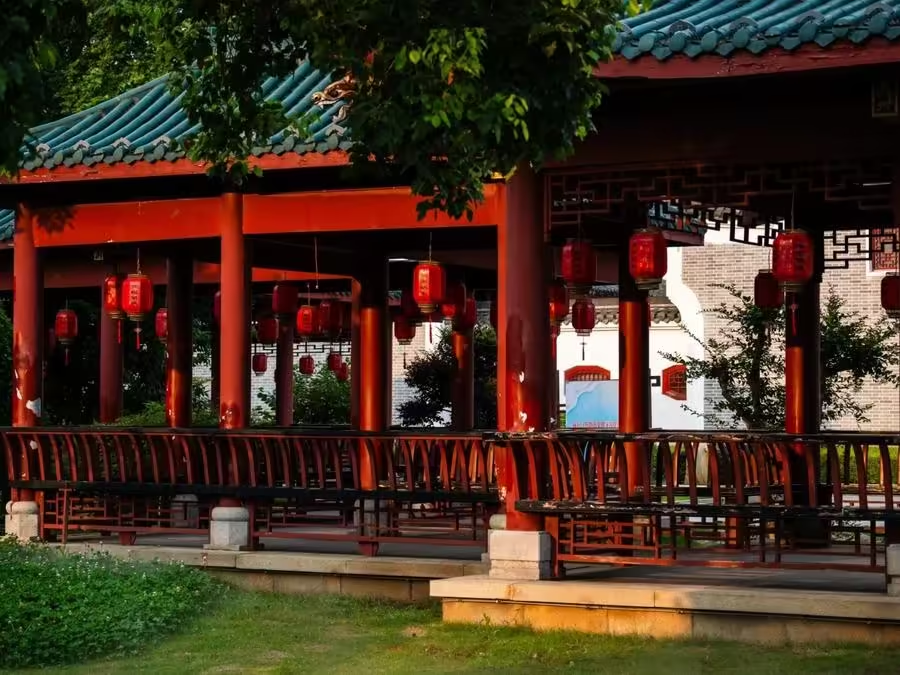Yueyang Tower (岳阳楼) is located on the western city wall of ancient Yueyang, overlooking Dongting Lake with a view of Junshan Island. Originally built during the Eastern Han Dynasty in 215 AD, the tower has undergone numerous renovations throughout history. The current structure retains the design and layout from its reconstruction during the Qing Dynasty in 1880. Yueyang Tower became renowned thanks to Northern Song Dynasty official Teng Zongliang’s restoration and the famous essay “Record of Yueyang Tower” written by his friend Fan Zhongyan. It is one of the “Three Great Towers of Jiangnan,” alongside Yellow Crane Tower in Wuhan and Tengwang Pavilion in Nanchang.
The tower’s design is unique, featuring a helmet-shaped roof resembling that of an ancient general. Remarkably, it was constructed without the use of nails or horizontal beams, making it a distinctive achievement in ancient Chinese architecture.
Within the Yueyang Tower scenic area, there are additional attractions. Near the entrance, the Wuchao Louguan (Five Dynasties Tower) section displays models of the tower from the Tang, Song, Yuan, Ming, and Qing dynasties. On the sand near the base of the tower, there are three large iron objects shaped like shackles, weighing 750 kg each, with their origin and purpose still debated. The park also has a dock where visitors can take a boat to the nearby Junshan Island.
Table of Contents
- Basic Information
- Location and Transportation
- Highlights of Yueyang Tower
- Vlog about Yueyang Tower
- History of Yueyang Tower
- Other Attractions in Yueyang Urban Area
Basic Information
| Estimated Length of Tour | 1 hour |
| Ticket Price | 70 RMB |
| Opening Hours | 7.30 – 18.00 |
| Telephone Number | 0086-0730-8899980 |
Location and Transportation
Yueyang Tower is located in the Yueyang Tower District of Yueyang City, Hunan Province, specifically at Dongting North Road. To get there, you can take bus 10, 15, 19, 22, 31, 37, 50, or Y21 and get off at Yueyang Tower Scenic Area Stop (岳阳楼景区站).
Highlights of Yueyang Tower
Main Tower

The main structure of Yueyang Tower faces east and stands 19.42 meters tall. It is a rectangular, three-story wooden building with four pillars and an eaved, helmet-shaped roof. The tower is 14.54 meters deep and 17.42 meters wide, with four large golden nanmu wood pillars running vertically through all three floors. The structure is interconnected by corridors, beams, rafters, and purlins, creating a unified architectural whole. The roof is adorned with glazed yellow tiles, giving the tower a stately and elegant appearance.
Inside, the first floor houses a carved screen featuring the famous “Record of Yueyang Tower,” along with poetry, couplets, and intricate carvings. The second floor prominently displays a zitan wood carving of the same record, penned by Qing Dynasty calligrapher Zhang Zhao. On the third floor, there is a screen inscribed with Mao Zedong’s handwritten version of Du Fu’s poem “Ascending Yueyang Tower.”
Sanzui Pavilion

Sanzui Pavilion (三醉亭), located to the north of Yueyang Tower, is one of the auxiliary pavilions and corresponds to Xianmei Pavilion. It is named after the legendary story of Lü Dongbin, one of the Eight Immortals, who was said to have become drunk three times at Yueyang Tower. The pavilion covers an area of 135.7 square meters and is 9 meters tall. It is a two-story, double-eaved structure with a hip-and-gable roof, featuring red pillars and green tiles. The doors and windows are intricately carved with detailed patterns, some depicting legendary stories. On the first floor, a carved screen displays a reclining image of Lü Dongbin.
Huaifu Pavilion

Huaifu Pavilion (怀甫亭) is located on the lakeside platform beneath Yueyang Tower, covering an area of 40 square meters and standing 7 meters tall. The pavilion is surrounded by railings, and its upper structure is entirely made of wood. Inside, a stone tablet is prominently displayed, featuring an engraving of the poet Du Fu‘s likeness and his famous poem “Ascending Yueyang Tower” on the front. The back of the tablet details his life story. Under the eaves on the northern side, a camphor wood plaque hangs, inscribed with the three characters “Huaifu Pavilion.” This pavilion serves as a memorial for the beloved poet Du Fu, commemorating his contributions to literature and culture in the Yueyang region.
Xianmei Pavilion

Xianmei Pavilion (仙梅亭) is situated on the southern side of Yueyang Tower and is one of the auxiliary pavilions, corresponding to Sanzui Pavilion. It is a hexagonal, two-story structure with three eaves and elegantly curved eaves at the corners. The pavilion covers an area of 44 square meters and stands 7 meters tall, topped with green glazed tiles.
Xianmei Pavilion has an interesting history dating back to the Ming Dynasty. In the twelfth year of the reign of Emperor Chongzhen (1639), the local magistrate, Tao Zongkong, oversaw the reconstruction of Yueyang Tower. During the construction, a stone was discovered among the sandy foundations, which, after being cleaned, revealed the image of a branch with twenty-four wilted plum blossoms. The people at the time considered this a miraculous discovery and named it “Xianmei,” meaning “Immortal Plum.” Consequently, the pavilion was built to house this stone, giving it the name “Xianmei Pavilion.”
Stone Tablet Gallery

On the eastern side of Yueyang Tower lies the Beilang (碑廊), an old stone tablet gallery shaped like an “L.” It measures 30 meters wide, 70.7 meters long, and has a height ranging from 2.65 to 5 meters. The gallery features inscriptions on both sides, containing a total of 139 stone tablets, with 158 engraved stones. Among these, 115 selected pieces showcase poems and calligraphy praising Yueyang Tower, while 24 memorial stones commemorate the repairs and renovations made to the tower since the Ming and Qing dynasties.
Vlog about Yueyang Tower
History of Yueyang Tower
Yueyang Tower (岳阳楼), located in Yueyang, Hunan Province, has a rich history that dates back to the Eastern Han Dynasty. Initially constructed in 215 AD by General Lu Su, it was originally called the “Yue Jun Lou” or “Reviewing Troops Tower.” The tower was built as a military structure to oversee troop movements and safeguard the region.
During the Western Jin Dynasty, the tower was renamed “Baling City Tower.” However, it faced destruction and was left in ruins until the Eastern Jin period, when it was rebuilt in 426 AD. This reconstruction marked a significant transition from a military facility to a scenic observation tower. It was during this time that the poet Yan Yanzhi visited and penned a poem that included the phrase “Qing Fen Ji Yueyang,” which is recognized as the first literary mention of “Yueyang.”
In 439 AD, the tower was renovated again, coinciding with the establishment of Baling County. Over the centuries, Yueyang Tower underwent numerous reconstructions and modifications. During the Tang Dynasty (618-907), particularly under Emperor Taizong’s reign, the tower was significantly expanded and received a new name: “South Tower” or “Yueyang City Tower.” The name “Yueyang Tower” was solidified during the middle Tang period, thanks to the famous poet Li Bai, who composed a poem celebrating the tower’s beauty.
The Northern Song Dynasty (960-1127) also saw several reconstructions, especially following devastating fires. Notably, in 1045, the tower was renovated by Teng Zongliang, the governor of Yuezhou. Yet, fires continued to plague the tower, with significant damage recorded in 1078, 1129, and again in 1138, leading to repeated restorations.
Under the Ming Dynasty (1368-1644), the tower continued to be a site of restoration, notably in the years 1426-1438 and 1472, although it was struck by lightning soon after a major renovation, resulting in considerable damage. The tower was rebuilt several times throughout the Ming and Qing Dynasties, with notable restorations taking place in 1615, 1638, and during the Kangxi era (1661-1722).
Throughout the Qing Dynasty, Yueyang Tower was again repaired multiple times. In 1740, the governor of Hunan approved significant funds for its restoration, which included constructing additional facilities around the tower. The Qing era saw the establishment of aesthetic enhancements, including the installation of calligraphy by prominent scholars and poets, further enhancing its cultural significance.
The tower faced significant challenges during the tumultuous periods of the early Republic of China and the Chinese Civil War. Numerous conflicts and natural disasters resulted in further damage, leaving the tower in a state of disrepair. In the early 20th century, efforts to restore the tower gained traction, and in 1934, it was successfully rebuilt, followed by additional restorations after 1949.






I visited Yueyang Tower because of its historical significance. When I arrived, it was undergoing repairs, and the interior was in disarray with a strong smell of paint. I think it’s worth a quick visit if you’re passing by, but it wouldn’t be necessary to go out of your way for it. In my opinion, the tourism management here is not as good as that of Tengwang Pavilion (滕王阁) and Bell and Drum Tower (钟鼓楼).
The entire Yueyang Tower Scenic Area is under renovation! Although the entrance fee is half price (original price 70 yuan), the experience is very disappointing! The only advantage is that there are very few people, so it’s good for taking photos.
From March 20th to the end of April, admission to Yueyang Tower is half price at 35 yuan.
Although the roads outside are under construction and maintenance is taking place inside, it does not affect the experience of seeing Yueyang Tower itself.